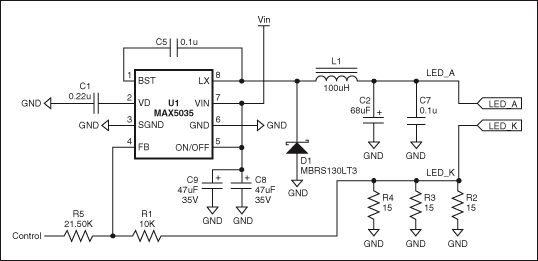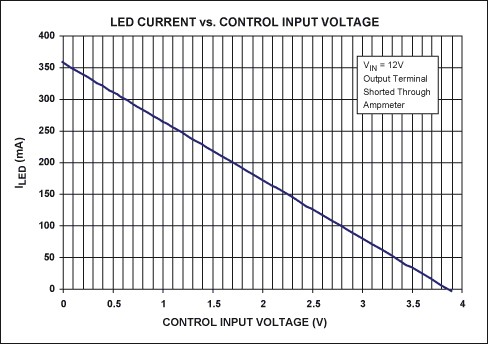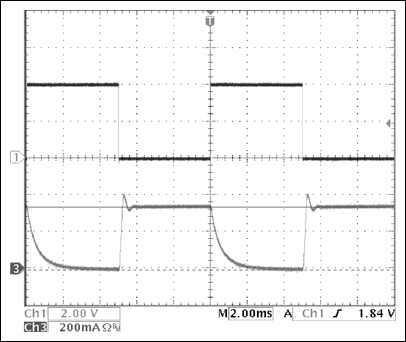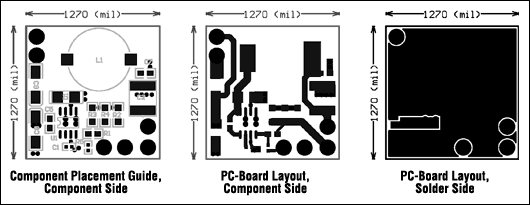Abstract: The simple circuit discussed in this article can regulate the drive current of high-brightness LEDs. This circuit uses a non-custom, highly integrated buck switching regulator (MAX5035) to accurately control the current flowing through the LED. The MAX5035 DC / DC converter maintains a fixed operating frequency of 125kHz over a wide input voltage range of 7.5V to 76V, making it ideal for automotive applications. Brightness control can be achieved by analog (linear adjustment) or low-frequency duty cycle (PWM adjustment).
Background of the development of high-brightness LEDs In recent years, high-brightness LEDs (HB LEDs) have become increasingly popular as light sources in various lighting systems. This is due to the high reliability of high-brightness LEDs, which can reach tens or even tens of thousands of hours , Which is several orders of magnitude longer than traditional incandescent or halogen lamps. Based on this advantage, high-brightness LEDs are widely used in automotive lighting, public signs and signal signs, and architectural lighting.
High-brightness LEDs are specially processed PN junction semiconductor devices that emit white, red, green, or blue light when forward biased (may also produce other colors of light). As PN junctions they exhibit VI characteristics similar to traditional diodes, but with a higher junction voltage drop. When the forward voltage reaches VF (from 2.5V for red LEDs to 4.5V for blue LEDs), the current flowing through the LED is very small; once the forward voltage reaches VF, the current will rise rapidly (same as traditional diodes). Therefore, current limiting measures must be used to limit the rise of current to prevent LED damage. There are currently three basic current limiting methods. Table 1 compares these three methods:
Table 1. Comparison of current limiting methods
¹Assuming a white LED: VF = 4V, ILED = 350mA, VIN = 12V. High-brightness LED switching power supply Figure 1 is a schematic diagram of a high-brightness LED power supply based on a fixed frequency, highly integrated PWM switching converter MAX5035, with an output current of up to 1A. The output current of another similar device MAX5033 can reach 500mA. This inductor-based buck regulator can accurately control the current flowing through the LED (or several LEDs in series with a total voltage of 12V). The switching frequency of the MAX5035 is 125kHz, and the input voltage range is up to 76V (higher voltage input capacitors and diodes are required). This circuit can control and maintain a constant LED current in a wide input voltage range. Table 2 summarizes the design specifications of the circuit.

Figure 1. By adjusting the control voltage (0V to 3.9V), the MAX5035 LED current driver can produce an output current of approximately 350mA to 0mA at the LED_A and LED_K terminals.
Table 2. Basic parameters of the circuit in Figure 1
Use the circuit of Figure 1 to apply a voltage at the control terminal to regulate the LED current (Figure 2). Figure 3 shows the efficiency of this control architecture.

Figure 2. The curve of the relationship between the LED current and the control voltage in the circuit of Figure 1. The current measurement value is obtained by the ammeter connected to the LED_A terminal and the LED_K terminal.

Figure 3. The circuit of Figure 1 shows the relationship between regulator efficiency and LED current when driving one, two, or three green 350mA series LEDs.
The control voltage and the voltages of three parallel sense resistors work together on the feedback (FB) pin of the IC. The internal control loop of the IC keeps the voltage of the FB pin at about 1.22V. Therefore, since both the control voltage and the current detection voltage must be maintained at 1.22V (set by resistors R1 and R5), a higher control voltage will produce more Small current.
In addition to this exception, the following equations can also be used to design other output currents and control voltages:

Among them: VREF = 1.22V, RSENSE is the parallel resistance value of R2, R3 and R4 (= 5Ω).
In many cases, it is very convenient to use low-frequency (50Hz to 200Hz) PWM mode to adjust the LED current, and adjust the brightness by controlling the pulse width (Figure 4). Although the LED maintains the same brightness during each pulse, the naked eye can detect short-term brightness changes, but the advantage of this adjustment method is that the spectrum remains unchanged, and when the amplitude adjustment is used, the spectrum will change with the change of the LED current .

Figure 4. The control of the low frequency PWM brightness adjustment and LED current waveform of the circuit in Figure 1. Ch1: VCONTROL, Ch3: ILED. The load is three green LEDs connected in series, and the total voltage is approximately 9.5V. Substituting a small output capacitor can reduce the amplitude of oscillation at turn-off.
When a square wave control waveform of 100 Hz, 0V to about 3.9V is used, the pulse of the LED current is shown in FIG. 4. In general, the efficiency of low-frequency PWM dimming circuits is higher than that of linear LED dimming circuits (Figure 2).

Figure 5. The PCB layout of the circuit shown in Figure 1. Conclusion The IC shown in Figure 1 (MAX5035, MAX5033) provides a cost-effective solution for driving high-brightness LEDs with constant current. Allows selection of small reactance devices (L1 and C2). Achieve high conversion efficiency over a wide input voltage range. The output voltage can reach 12V and can drive three high-intensity green LEDs connected in series. No mechanical radiator is required. The voltage range can be extended to 76V, suitable for driving high-brightness LEDs in automobiles. Can be used for 24V signal lights and architectural lighting. By changing the value of the current detection resistors R2, R3 and R4, the output current can reach 1A. Built-in switching power MOSFET simplifies design. The brightness of the LED can be adjusted by controlling the input pin and using analog voltage amplitude (linear dimming). Through the control input, the low-frequency PWM signal is used to adjust the brightness.
Background of the development of high-brightness LEDs In recent years, high-brightness LEDs (HB LEDs) have become increasingly popular as light sources in various lighting systems. This is due to the high reliability of high-brightness LEDs, which can reach tens or even tens of thousands of hours , Which is several orders of magnitude longer than traditional incandescent or halogen lamps. Based on this advantage, high-brightness LEDs are widely used in automotive lighting, public signs and signal signs, and architectural lighting.
High-brightness LEDs are specially processed PN junction semiconductor devices that emit white, red, green, or blue light when forward biased (may also produce other colors of light). As PN junctions they exhibit VI characteristics similar to traditional diodes, but with a higher junction voltage drop. When the forward voltage reaches VF (from 2.5V for red LEDs to 4.5V for blue LEDs), the current flowing through the LED is very small; once the forward voltage reaches VF, the current will rise rapidly (same as traditional diodes). Therefore, current limiting measures must be used to limit the rise of current to prevent LED damage. There are currently three basic current limiting methods. Table 1 compares these three methods:
Table 1. Comparison of current limiting methods
| Current limiting method | advantage | Disadvantages | Power consumption¹ |
| resistance | Low price; only one device (although larger); | Can not accurately control the current; the current follows the power supply voltage to some extent; the power consumption on the resistor is large, and the size of the resistor must be determined accordingly; | 2.8W |
| Active linear control | Linear control loop accurately controls LED current; controls dimming current; can achieve amplitude and low-frequency PWM adjustment; can realize automatic temperature compensation of LED characteristics; | Higher cost than simple resistor current limiting; power consumption of power supply is the same as resistance current limiting scheme; may require heat sink; | 2.8W |
| Switch regulation control | The control loop can accurately adjust the LED current; can achieve amplitude and low-frequency PWM adjustment; can realize automatic temperature compensation of LED characteristics; wide input voltage range; basically no radiator is needed, which can save costs and reduce assembly complexity; for high Input voltage and large operating current, other driving schemes will cause very high losses, this mode can maintain efficient operation. | Compared with resistance and linear control methods, the circuit cost is higher; EMI needs to be considered, and the circuit must be designed carefully; active circuits may require more space. But other current limiting methods require larger heat sinks and physical space. | <0.8W |
¹Assuming a white LED: VF = 4V, ILED = 350mA, VIN = 12V. High-brightness LED switching power supply Figure 1 is a schematic diagram of a high-brightness LED power supply based on a fixed frequency, highly integrated PWM switching converter MAX5035, with an output current of up to 1A. The output current of another similar device MAX5033 can reach 500mA. This inductor-based buck regulator can accurately control the current flowing through the LED (or several LEDs in series with a total voltage of 12V). The switching frequency of the MAX5035 is 125kHz, and the input voltage range is up to 76V (higher voltage input capacitors and diodes are required). This circuit can control and maintain a constant LED current in a wide input voltage range. Table 2 summarizes the design specifications of the circuit.

Figure 1. By adjusting the control voltage (0V to 3.9V), the MAX5035 LED current driver can produce an output current of approximately 350mA to 0mA at the LED_A and LED_K terminals.
Table 2. Basic parameters of the circuit in Figure 1
| parameter | value |
| Minimum input voltage (V) | 7.5 (most single LEDs) |
| Maximum input voltage (V) | 30 (limited by D1, C8 and C9) |
| Maximum output current (mA) | 350 (VCONTROL = 0V) |
| Maximum output voltage (V) | 12 (Limited internally by MAX5035, output current 350mA) |
| Control voltage range (VCONTROL) (V) | 0 (full current) to 3.9 (all dimmed) |
Use the circuit of Figure 1 to apply a voltage at the control terminal to regulate the LED current (Figure 2). Figure 3 shows the efficiency of this control architecture.

Figure 2. The curve of the relationship between the LED current and the control voltage in the circuit of Figure 1. The current measurement value is obtained by the ammeter connected to the LED_A terminal and the LED_K terminal.

Figure 3. The circuit of Figure 1 shows the relationship between regulator efficiency and LED current when driving one, two, or three green 350mA series LEDs.
The control voltage and the voltages of three parallel sense resistors work together on the feedback (FB) pin of the IC. The internal control loop of the IC keeps the voltage of the FB pin at about 1.22V. Therefore, since both the control voltage and the current detection voltage must be maintained at 1.22V (set by resistors R1 and R5), a higher control voltage will produce more Small current.
In addition to this exception, the following equations can also be used to design other output currents and control voltages:

Among them: VREF = 1.22V, RSENSE is the parallel resistance value of R2, R3 and R4 (= 5Ω).
In many cases, it is very convenient to use low-frequency (50Hz to 200Hz) PWM mode to adjust the LED current, and adjust the brightness by controlling the pulse width (Figure 4). Although the LED maintains the same brightness during each pulse, the naked eye can detect short-term brightness changes, but the advantage of this adjustment method is that the spectrum remains unchanged, and when the amplitude adjustment is used, the spectrum will change with the change of the LED current .

Figure 4. The control of the low frequency PWM brightness adjustment and LED current waveform of the circuit in Figure 1. Ch1: VCONTROL, Ch3: ILED. The load is three green LEDs connected in series, and the total voltage is approximately 9.5V. Substituting a small output capacitor can reduce the amplitude of oscillation at turn-off.
When a square wave control waveform of 100 Hz, 0V to about 3.9V is used, the pulse of the LED current is shown in FIG. 4. In general, the efficiency of low-frequency PWM dimming circuits is higher than that of linear LED dimming circuits (Figure 2).

Figure 5. The PCB layout of the circuit shown in Figure 1. Conclusion The IC shown in Figure 1 (MAX5035, MAX5033) provides a cost-effective solution for driving high-brightness LEDs with constant current. Allows selection of small reactance devices (L1 and C2). Achieve high conversion efficiency over a wide input voltage range. The output voltage can reach 12V and can drive three high-intensity green LEDs connected in series. No mechanical radiator is required. The voltage range can be extended to 76V, suitable for driving high-brightness LEDs in automobiles. Can be used for 24V signal lights and architectural lighting. By changing the value of the current detection resistors R2, R3 and R4, the output current can reach 1A. Built-in switching power MOSFET simplifies design. The brightness of the LED can be adjusted by controlling the input pin and using analog voltage amplitude (linear dimming). Through the control input, the low-frequency PWM signal is used to adjust the brightness.
Thyristor Module is one of the most commonly used semiconductor devices because of its small size, simple structure and strong function.This device has been widely applied in various kinds of electronic equipment and electronic products, used as a rectifier, inverter, frequency, voltage regulator, contactless control of motor speed, motor excitation, non-contact switch and the power control, etc.
Thyristor Module
Thyristor Module,High Current Thyristor Module,Air Cooling Thyristor Module,Standard Voltage Thyristor Module
YANGZHOU POSITIONING TECH CO., LTD. , https://www.yzpst.com